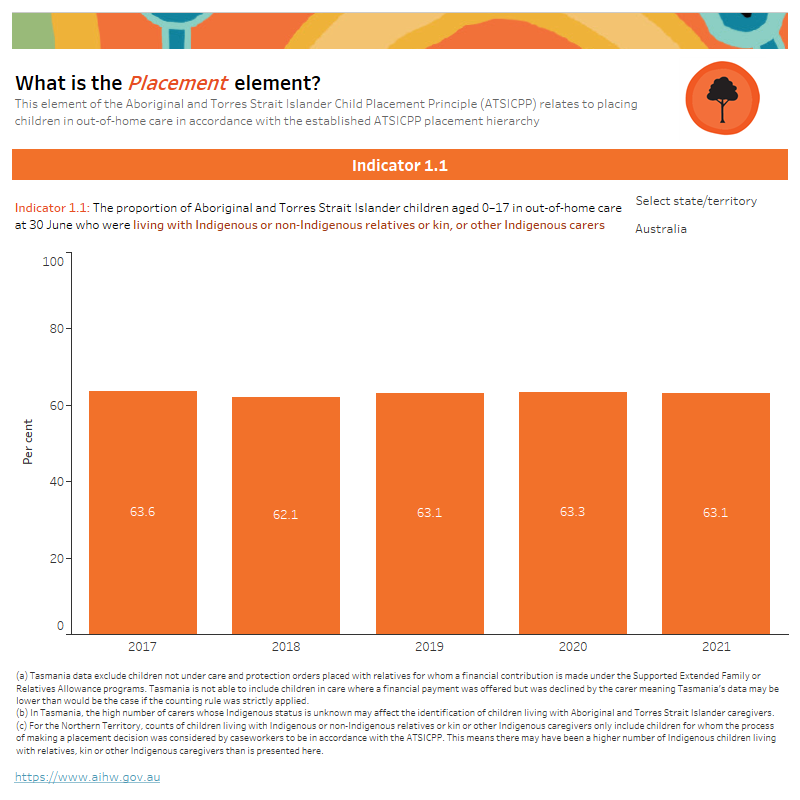Placement
The Placement element of the Aboriginal and Torres Strait Islander Child Placement Principle (ATSICPP) sets a hierarchy of preferred placement options for carers of Aboriginal and Torres Strait Islander children in out-of-home care. The placement hierarchy is designed to ensure the highest possible level of connection to family, community, culture and country is maintained for an Aboriginal and Torres Strait Islander child in out-of-home care.
The placement hierarchy is as follows:
- With Aboriginal and Torres Strait Islander or non-Indigenous relatives or extended family members (kin),
- With Aboriginal and Torres Strait Islander members of the child’s community; or
- With Aboriginal and Torres Strait Islander family-based carers.
The 3 options above are preferred placement types. If these preferred options are not available, as a last resort, the child may be placed in:
- Another care arrangement (such as with a non-Indigenous carer or in a residential setting).
If the child is not placed with their relatives or kin (that is, level 1 in the placement hierarchy), the placement should be within close geographic proximity to the child’s family (SNAICC 2018).
Application of the Placement element means fully exhausting all possible options at the highest level of the placement hierarchy before considering options at the next level down. Best practice application of the Aboriginal and Torres Strait Islander Child Placement Principle (ATSICPP) also includes regular review of placements at lower levels of the hierarchy (e.g. those with non-Indigenous carers who are not relatives or kin, or in residential settings) to enable children to be moved to a higher level placement if circumstances change (e.g. to live with relatives or Aboriginal and Torres Strait Islander community members).
The bar chart shows the proportions of Aboriginal and Torres Strait Islander children in out-of-home care at 30 June who were living in preferred placements, from 2017 to 2021 and for each state and territory. Preferred placements are defined as living with relatives, kin or other Aboriginal and Torres Strait Islander carers. The chart shows that the proportion living in preferred placements at 30 June 2021 is 63% nationally and has remained around 63% since 30 June 2017.

Source: AIHW Child Protection Data Collection
See the supplementary data tables for further information and footnotes about these data. See the background information and technical specifications for information on counting rules for this indicator.
The application of the Placement element can be measured by determining the types of carers Aboriginal and Torres Strait Islander children in out-of-home care have been placed with; or more specifically, a carer’s relationship to the child. This is measured by indicator 1.1 (to explore data on indicator 1.1, go to the Tableau dashboard):
At 30 June 2021:
- 63% of the 19,500 Aboriginal and Torres Strait Islander children aged 0–17 in out-of-home care were living with Aboriginal and Torres Strait Islander or non-Indigenous relatives or kin or other Aboriginal and Torres Strait Islander carers.
- in jurisdictions with published data, children living with Aboriginal and Torres Strait Islander relatives or kin made up the largest group of children in preferred placements except in Tasmania.
The proportion of children in preferred placement types (the placements numbered 1, 2 and 3 in the placement hierarchy) has remained stable since 2017.
Explanatory notes
It should be noted that looking at who a child is eventually placed with is just one way of measuring the application of the Placement element. Application of this element also requires that active efforts are made to find a child’s family, to consult with a child’s family, community representatives and/or Aboriginal Community Controlled Organisations, to inform placement decisions and to provide support to carers to maximise the success of the placement while minimising the chance of placement breakdown (SNAICC 2017).
Active efforts also include ensuring that a child’s Aboriginal and/or Torres Strait Islander status is recorded accurately. The coverage of Indigenous status data for children in out-of-home care is generally very high – at 30 June 2021, Indigenous status was unknown for less than 1% of children in out-of-home care nationally. However, it is unknown whether, or to what extent, Aboriginal and Torres Strait Islander children are being incorrectly recorded as non-Indigenous. Active efforts to address this and the other issues highlighted are intended to improve the chance that a preferred placement (that is, the placements numbered 1, 2 and 3 in the placement hierarchy) will be found for a child. Indicators relating to some of these active efforts are in development.
Placement indicators under development
The following indicators are currently under development under Placement:
| Number | Indicator |
|---|---|
| Under development | Aboriginal and Torres Strait Islander children in out-of-home care who were reconnected to Aboriginal and Torres Strait Islander relatives and kin through placement change |
| Under development | Aboriginal and Torres Strait Islander children in out-of-home care who were reconnected to Aboriginal and Torres Strait Islander relatives and kin through placement change and remained with relatives for 12 months or more |
| Under development | Aboriginal and Torres Strait Islander children in out-of-home care living with Aboriginal and Torres Strait Islander relatives or kin for the first time |
References
SNAICC – National Voice for our Children (2017) Understanding and applying the Aboriginal and Torres Strait Islander Child Placement Principle: a resource for legislation, policy, and program development, SNAICC, accessed 16 June 2020.
SNAICC – National Voice for our Children (2018) The Aboriginal and Torres Strait Islander Child Placement Principle: a guide to support implementation, SNAICC, accessed 16 June 2020.


